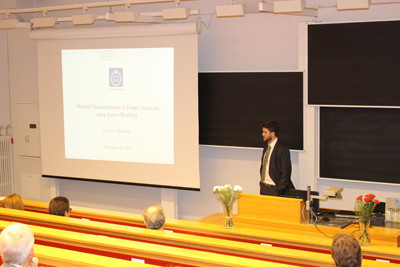Rules and guideines regarding PhD defence at KTH

In Swedish: Anvisning om betygsnämnd för betygssättning av doktorsavhandling (pdf 320 kB)
In English: The composition of the Grading Board and the authority to give reasons for decisions on grades (pdf 137 kB)
All about thesis, disputation and qualification is under this link
More on the topic:
Unofficial translation of the KTH regulation V -2016-0737 “Anvisning om disputation”
(by Per Berglund 2016-10-02)
The main supervisor suggests opponents, members of the examination committee and chairman of the defence.
Decisions on the defence
The Director of third cycle education at the School decides on the defence, including decisions on the time and place for this. The Director of third cycle education at the School also appoints the opponent, examination committee members, and chairman of the defence. The school is responsible for that the decision on the defense is distributed to interested parties and that information is laid out in KTH's calendar. The school is responsible for the distribution of the thesis according to an established distribution list. Chairman of the Dissertation The school’s director of third cycle education appoints the chair of the defense. The chairperson at the public defense is responsible for that the defense is being conducted as intended. This refers to that the formalities are followed and that the respondent, the opponent and the examination committee are given the conditions necessary for a successful presentation and opposition. The Chairperson of the defense must be a person other than any of the supervisors. The chairperson shall submit the form for the examination committee protocol to the examination committee. The chairperson should also ensure that this protocol can be submitted directly to the school's office after the meeting has ended.
Description of the defence
Present at the thesis defense is the opponent, the doctoral student (respondent), the examination committee members, the chairperson and, as a rule, the main supervisor, and, moreover, the defense is open to the interested public. The main actors at the defence are the opponent and the respondent, but it is also very important that the examination committee members actively participate in the discussion of the dissertation at their allocated time described below. There are no detailed regulations on how the opposition and the defense of the dissertation should be done. A defence at KTH normally follows the procedure described below, but slight deviations may occur.
1. The Chairperson greets those present and introduces the respondent and the opponent. The chairperson describes where the research has been conducted, and introduces the supervisor(s). The chairperson concludes the introduction by informing that everyone will be given the opportunity to ask questions after the opponent's review.
2. The Chairperson gives the floor to the respondent, so that he/she gets the opportunity to comment on any formal errors in the dissertation.
3. Next, the respondent - or in some cases, the opponent – gives a short summary of the thesis. The content of this lecture can, among other things, be a definition of the research problem, a description of the achievements and the scientific and social interest of the results of the research. The summary should focus on the current thesis and may not be a lecture on current research problems in general. If the opponent is giving this lecture, then the respondent is given the opportunity to briefly comment on and complement the summary. (approx. 30 min)
4. The opponent discusses the thesis with the respondent and should mainly ask questions concerning the work described in the thesis. The discussion should not have the nature of a general questioning. Sometimes, however, it is necessary to ask questions of a more general nature. The opponent explains that her/his assessment is completed and congratulates if he / she so wishes, the respondent. During this part of the defense, the audience does not participate in the discussion. (approx. 60 min)
5. After the opponent's assessment is concluded, the Chairperson invites the examination committee members to discuss the issues that they consider need to be further elucidated by the respondent. The Chairperson should give the word to each one of the committee.
6. The Chairperson invites everyone present to ask questions and / or comment on the thesis. In this discussion that may follow, the main supervisor, the opponent and the respondent are allowed to participate.
7. The Chairperson then thanks the opponent and respondent, on the University's behalf and announces that the committee will now meet followed by an announcement of their decision (probably at an arranged reception to which everyone is invited). A Full thesis defence usually takes about 2-3 hours. The examination committee meets as soon as possible after the defense. The Chairperson leaves the form for the examination committee protocol to the examination board. The opponent and the supervisor normally attends the meeting.

